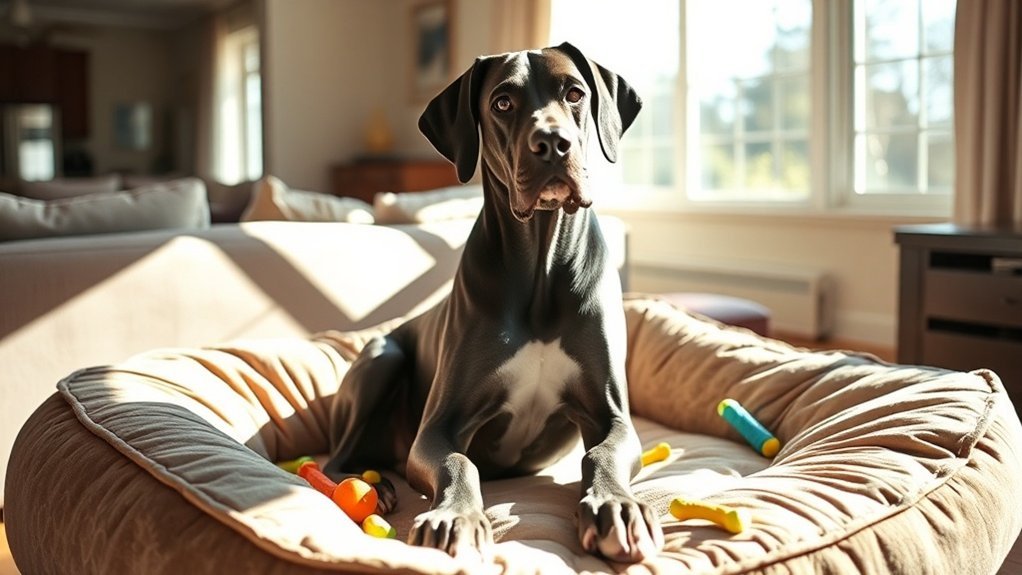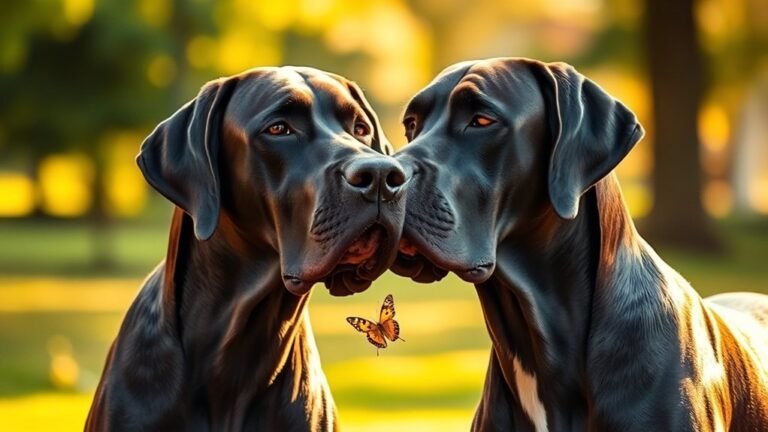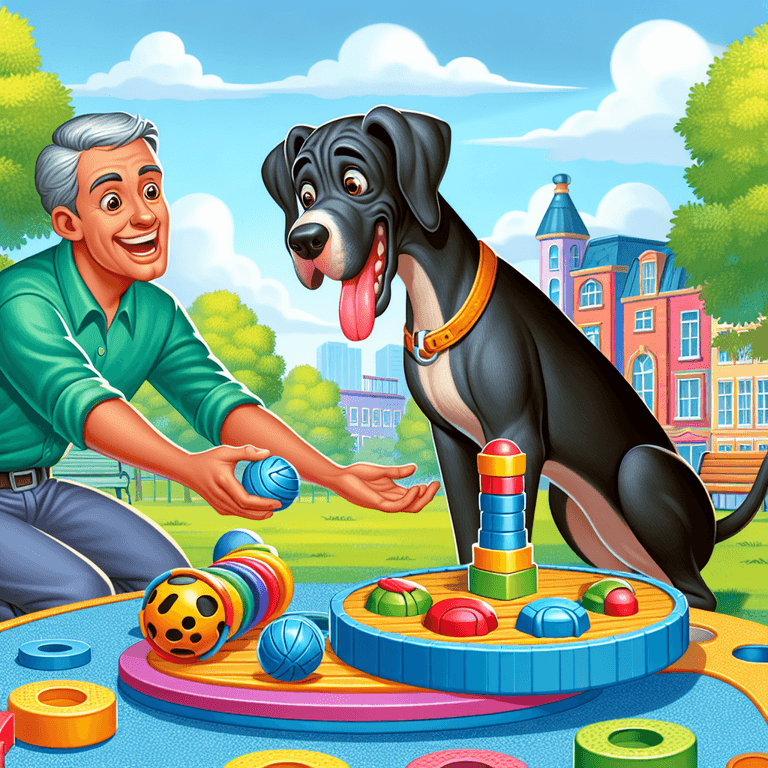Words I Know: Treat. Words I Ignore: Bath
Woof! Hi there, humans! Let me tell you something amazing about us, Great Danes – we understand way more than you think we do. In fact, we can figure out around 165 of your human words! Pretty impressive for a dog who’s mostly thinking about treats and nap time, right?
Here’s the thing that cracks me up about you humans – you think we don’t know what you’re saying when you spell out W-A-L-K or T-R-E-A-T. News flash: we figured that out ages ago! We’re not just pretty faces with floppy ears, you know.
What’s cool is how we connect your words to awesome stuff. When you say “dinner,” my brain immediately thinks “BEST TIME EVER!” When you say “bath,” well… let’s just say I suddenly remember something vital I need to do in the other room.
The funny part is how your tone changes everything. You could say “good boy” in a happy voice, and I’m doing my wiggle dance. Say it in a grumpy voice? Uh oh, what did I do this time? Was it the shoe? It was probably the shoe.
Each of us Great Danes has our own personality when it comes to learning words. Some of us are like furry scholars, picking up new words super fast. Others of us… Well, we’re more focused on important things like finding the perfect sunny spot for our third nap of the day.
The best part is when you humans finally realize how smart we are and start having honest conversations with us. Trust me, we’ve been waiting for this our whole lives!
Understanding Canine Word Comprehension
What’s That Word Again? A Great Dane’s Guide to Human Language
So get this – scientists say we can learn around 165 words! That’s like a whole vocabulary test, except way more fun because nobody’s grading us. I personally know way more than that, but who’s counting? (Okay, the scientists are counting, but whatever.)
The thing is, us dogs are pretty smart cookies – or should I say smart dog biscuits? We’re constantly making connections between the sounds you humans make and what happens next. When my human says “walk,” my brain immediately thinks “OH BOY OH BOY, LEASH TIME!”
Us dogs are clever critters, linking your words to our adventures—like when “walk” makes us think “leash time!”
When they say “treat,” well, let’s just say my tail starts wagging before they even finish the word.
What’s really cool is how we connect words to feelings, too. When my human uses their happy voice and says “good boy,” I know I’ve done something right.
But when they use that serious tone and say “no,” I know I probably shouldn’t have eaten that entire sandwich off the counter. (Sorry, not sorry – it smelled amazing.)
The more you talk to us, the better we get at understanding you. It’s like having a conversation, except I primarily respond with tail wags and the occasional dramatic sigh when you’re taking too long to open the treat jar.
Trust me, we’re always listening – even when we pretend we can’t hear you calling us to come inside from the backyard! Understanding body language signals can also help you communicate even better with us, making our bond even stronger.
Great Danes: A Unique Perspective on Language
Woof! Let me tell you something about us Great Danes – we’re the smartest dogs you’ll ever meet, and we understand way more than you think we do.
You humans are always surprised when we tilt our massive heads at you, but here’s the secret: we’re not just being adorable (though we are). We’re trying to figure out what the heck you’re saying! Your words are like puzzles to us, and we love solving them.
When you talk to us, we don’t just hear “blah blah blah WALK blah blah TREAT.” Nope! We’re listening to how your voice sounds – are you happy, sad, or about to give us that look because we knocked over the coffee table again? We can tell the difference between “Good boy!” when you really mean it and “Good boy…” when you’re just being polite, especially when we drooled on your friend.
Our tail wagging isn’t random either. It’s like our version of texting back. Fast wags mean “YES, I’M EXCITED!” Slow wags mean “I’m listening, keep talking.”
And when we do that thing where we lean our entire 150-pound body against you? That’s us saying, “I understand you, human, and I’m here for you.”
Sure, other dogs might know a few tricks, but us Great Danes? We’re like the honor students of the dog world. Our adaptive intelligence helps us learn commands quickly and solve problems effectively.
We remember your routines, your moods, and definitely where you hide the good treats. We just choose to act goofy sometimes because, let’s face it, being this smart all the time is exhausting!
Factors Influencing Intelligence in Great Danes
Intelligence in us Great Danes isn’t just about knowing when someone says “sit” or “stay.” There’s a lot more going on in our big furry heads!
Some of us are born naturally more intelligent than others – it’s all in our genes. Just like how some humans are better at math while others rock at art, some Great Dane families produce super-smart pups while others might need a little extra time to figure things out.
Some Great Danes are born brainiacs while others take their time—just like humans with their unique talents!
The way humans train us makes a huge difference, too. When our people use treats, praise, and patience, we learn way faster than when they get frustrated with us.
Trust me, we can tell when you’re happy with us, and it makes our tails wag and our brains work overtime! We want to make you proud, which is why positive training gets us excited to learn new tricks.
Here’s the thing, though – we Great Danes are sensitive souls in giant bodies. When we feel loved and understood, we’re like furry Einstein dogs.
But when we’re stressed or confused, our brains tend to shut down. Think of it like trying to do homework while someone’s yelling at you – not easy, right?
Every Great Dane has its unique intelligence. Some of us are great at reading human emotions, others excel at problem-solving, and some are natural comedians who know precisely when to make you laugh.
We might be gentle giants, but don’t underestimate what’s happening between those floppy ears! Positive reinforcement techniques can significantly enhance our learning and foster a deeper connection with our humans.
Measuring Your Great Dane’s Intelligence
Measuring my intelligence isn’t just about how many commands I can follow (though I’m pretty good at “sit” when treats are involved). It’s about understanding my unique strengths and how I interact with the world around me – which looks pretty different from up here at my towering height!
You humans can explore my cognitive skills through word association, watching how quickly I connect words to actions or objects. Trust me, I know the difference between “walk,” “treat,” and “bath” – and my tail-wagging intensity changes dramatically depending on which one you say.
When you watch me solve puzzles or navigate new environments, you’re seeing my problem-solving abilities in action. Though I should mention that sometimes I forget how big I am and try to squeeze through spaces meant for much smaller dogs.
Each interaction we’ve had provides insight into my thought processes. Like when I carefully calculate whether that squirrel is worth chasing or if the couch looks more comfortable. Additionally, my understanding of commands reflects my strong bond with you and the protective instincts that drive me to stay close by.
The Role of Temperament in Learning and Comprehension
Take me, for example. I’m what you might call a “chill” kind of dog. I like it when my humans talk to me softly and show me what they want me to do. Don’t yell at me, or I might just plop down and pretend I’m suddenly very sleepy.
My son Thor, though? That guy is like a furry tornado! He loves when training time feels like a game with lots of running around and high-fives.
My son Thor is a whirlwind of energy, thriving on playful training sessions filled with excitement and high-fives!
We Great Danes are pretty smart cookies, but we need you humans to pay attention to our moods. If I’m feeling grumpy because someone forgot to fill my food bowl (hint, hint), I’m probably not going to be very interested in learning how to shake hands.
But when I’m happy and my tail is wagging so hard it might knock over your coffee table, that’s when I’m ready to show off my brain power!
Here’s a secret: we can tell when you’re getting frustrated with us. Trust me, we know. And when that happens, we get stressed out too.
But when you’re patient with us and maybe slip us a treat or two, we want to make you proud. Proper training techniques play a big role in how well we understand what you want.
The best part about learning together is that we both get better at understanding each other. You know that I need extra time to think things through (I am quite large, after all), and I learn that sitting nicely gets me belly rubs. It’s a win-win situation!
Final Thoughts
Woof! So you want to know how many words I understand? Well, let me tell you – it’s way more than you think! We Great Danes can understand about 165 words on average.
Here’s the thing, though – I probably understand way more than my humans realize. Sure, I know the basics like “sit,” “stay,” and “dinner” (my personal favorite). But I also pick up on sneaky words like “vet,” “bath,” and “no more treats.” Trust me, I know when you spell out W-A-L-K, too!
What gets me excited is how my family and I can communicate better when they realize how smart I am. When they use words I know and give me time to think, our friendship gets even stronger. It’s like we’re having honest conversations – well, except I mostly wag my tail and drool a little.
The best part? The more my humans talk to me and teach me new words, the more I learn! So keep chatting with us, gentle giants. We’re listening to every word – especially if it involves food or belly rubs!
References
- https://gladdogsnation.com/blogs/blog/are-great-danes-smart-the-science-behind-the-breeds-intelligence
- https://www.wanderlustdanes.com/health-and-breeder-resources-blog/understanding-great-dane-genetics-the-basics
- https://sploot.space/resources/everything-a-great-dane-dog-breed-parent-must-know
- http://yaresville.com/standard/judging-great-danes
- https://en.wikipedia.org/wiki/Great_Dane






